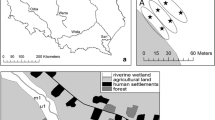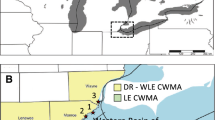Abstract
A population of “Gulf Coast haplotype” Phragmites australis occurring at the periphery of a hypereutrophic lake in Central Florida was sampled to determine biomass and nutrient stand attributes. This data was also used to investigate harvest potential and timing with respect to sustainable stand management and nutrient removal. This Phragmites type produces biomass and stores nutrients in similar quantities to moderately loaded stands elsewhere however patterns of production, storage, and nutrient translocation differ greatly. The growing season for these stands extended from February to early December. Stands present peak biomass (800–1,200 g m−2) and Phosphorus storage (1.7–1.8 g m−2) both at the very end and beginning of the growing season with a smaller peak in summer; this multi-modal pattern differs from unimodal patterns previously reported. Pulses of available nutrients as the marsh floods may be driving nutrient cycling in concert with seasonality. These morphological and functional patterns provide a flexible harvest strategy. Harvest in either late fall or early spring would address 28 and 23 % of the Lake’s Pollutant Load Reduction Goal, respectively. The dual objectives of maximum nutrient removal and stand sustainability can be met through careful examination of nutrient storage and translocation results gleaned from this study, as well as, ongoing in situ harvest experiments to test emergent hypothesis. This investigation has yielded important baseline data for the little studied Gulf Coast haplotype of P. australis occurring in the southeastern United States as well as a wetland management technique for nutrient reduction in impaired aquatic ecosystems.







Similar content being viewed by others
References
Afrous A, Hedayat N, Liaghat A, Mohammadpour M, Manshouri M (2010) Accumulation and uptake of nitrogen and P by four species of aquatic plants under arid and semi-arid conditions of Desful, Iran. World Appl Sci J 10:886–891
Asaeda T, Karunaratne S (2000) Dynamic modeling of the growth of Phragmites australis: model description. Aquat Bot 67:301–318
Asaeda T, Rajapakse L, Manatunge J, Sahara N (2006) The effect of summer harvesting on Phragmites australis on growth characteristics and rhizome resource storage. Hydrobiologia 553:327–335
Asaeda T, Sharma P, Rajapakse L (2008) Seasonal patterns of carbohydrate translocation and synthesis of structural carbon components in Typha angustifolia. Hydrobiologia 607:87–101
Brown MT, Boyd MC (2010) Experimental Phragmites harvest to reduce TP in Lake Jesup: a project in Lake Jesup Total Phosphorus (TP) Removal Treatment Technologies. Final Project Report, Contract #25420. St. Johns River Water Management District, Palatka, FL, pp 1–52
Cronk J, Fennessy M (2001) Wetland plants: biology and ecology. CRC Press, Boca Raton
Eid EM, Shaltout KH, Al-Sodany YM, Soetaert K, Jensen K (2010) Modeling growth, carbon allocation, and nutrient budgets for Phragmites australis in Lake Burullus, Egypt. Wetlands 30:240–251
England G, Listopad C (2012). Use of TMDL credits for BMP comparisons. Stormwater. http://www.stormh2o.com/SW/Editorial/Use_of_TMDL_Credits_for_BMP_Comparisons_16777.aspx. Accessed 28 Dec 2014
Engloner AI (2004) Annual growth dynamics and morphological differences of reed (Phragmites australis [Cav.] Trin. ex Steudel) in relation to water supply. Flora Morphol Distrib Funct Ecol Plants 199:256–262
Florida Department of Environmental Protection (2008) Florida Fish and Wildlife Conservation Service, and St. Johns River Water Management District. Lake Jesup Interagency Restoration Strategy
Gao X (2006) TMDL Report: nutrient and Unionized Ammonia TMDLs for Lake Jesup, WBIDs 2981 and 2981A. Florida Department of Environmental Protection, Division of Water Resource Management, Bureau of Watershed Management, Tallahassee, FL, pp 1–130
Graneli W (1990) Standing crop and mineral content of reed, Phragmites australis (Cav.) Trin. ex Steudel, in Sweden—management of reed stands to maximize harvestable biomass. Folia Geobot Phytotaxon 25:291–302
Graneli W, Weisner S, Sytsma M (1992) Rhizome dynamics and resource storage in Phragmites australis. Wetland Ecol Manag 1:239–247
Greenway M (1997) Nutrient content of wetland plants in constructed wetlands receiving municipal effluent in tropical Australia. Water Sci Technol 35:135–142
Hazen and Sawyer PC (2011) Compilation of benefits and costs of STA and reservoir projects in the South Florida Water Management District. Prepared for the World Wildlife Fund acting on behalf of the Florida Ranchlands Environmental Services Project, pp 1–66
Headley TR, Davison L, Huett DO, Műller R (2012) Evapotranspiration from subsurface horizontal flow wetlands planted with Phragmites australis in sub-tropical Australia. Water Res 46:345–354
Hocking PJ (1989a) Seasonal dynamics of production, and nutrient accumulation and cycling by Phragmites australis (Cav.) Trin. ex Steudel in a nutrient-enriched swamp in inland Australia. I. Whole plants. Aust J Mar Freshw Res 40:421–444
Hocking PJ (1989b) Seasonal dynamics of production, and nutrient accumulation and cycling by Phragmites australis (Cav.) Trin. ex Steudel in a nutrient-enriched swamp in inland Australia. II. Individual shoots. Aust J Mar Freshw Res 40:445–464
Kadlec RH, Knight RL (1996) Treatment wetlands. CRC Press/Lewis Publishers, Boca Raton
Karunaratne S, Asaeda T, Yutani K (2003) Growth performance of Phragmites australis in Japan: influence of geographic gradient. Environ Exp Bot 50:51–66
Karunaratne S, Asaeda T, Yutani K (2004) Shoot regrowth and age-specific rhizome storage dynamics of Phragmites australis subjected to summer harvesting. Ecol Eng 22:99–111
Lippert I, Rolletschek H, Kuhl H, Kohl J (1999) Internal and external nutrient cycles in stand of Phragmites australis—a model for two ecotypes. Hydrobiologia 408/409:343–348
Mason CF, Bryant RJ (1975) Production, nutrient content, and decomposition of Phragmites australis and Typha angustifolia. J Ecol 63:71–96
Meuleman A, Beekman J, Verhoeven J (2002) Nutrient retention and nutrient-use efficiency in Phragmites australis stands after wastewater application. Wetlands 22:712–721
Meyerson L, Saltonstall K, Windham L, Kiviat E, Findlay S (2000) A comparison of Phragmites australis in freshwater and brackish marsh environments in North America. Wetlands Ecol Manag 8:89–103
Murray-Hudson M, Mmopelwa G (2011) Biomass production and economic value of Phragmites australis reedbeds in the Southern Okavango Delta, Botswana. Afr J Plant Sci Biotechnol 5:16–20
Overholt WA, Diaz R, Hanson M, Williams D (2012) Phragmites in Florida (ENY-860). Department of Entomology and Nematology, Florida Cooperative Extension Service, Institute of Food and Agricultural Sciences, University of Florida, Gainesville, FL
Ruiz M, Velasco J (2010) Nutrient bioaccumulation in Phragmites australis: management tool for reduction of pollution in Mar Menor. Water Air Soil Pollut 205:173–185
Saltonstall K (2003) Genetic variation among North American populations of Phragmites australis: implications for management. Estuaries 26:444–451
Soetaert K, Hoffmann M, Meire P, Starink M, van Oevelen D, Van Regenmortel S, Cox T (2004) Modeling growth and carbon allocation in two reed beds (Phragmites australis) in the Scheldt estuary. Aquat Bot 79:211–234
Tanner CC (1996) Plants for constructed wetland treatment systems—a comparison of growth and nutrient uptake of eight emergent species. Ecol Eng 7:59–83
Theves N, Zerbe S, Gahlert F, Migit M, Succow M (2007) Productivity of reed (Phragmites australis Trin. ex Steud.) in continental-arid NW China in relation to soil, groundwater, and land-use. J Appl Bot Food Qual 81:62–68
Toet S, Bouwman M, Cevaal A, Verhoeven J (2005) Nutrient removal through autumn harvest of Phragmites australis and Typha latifolia shoots in relation to nutrient loading in a wetland system used for polishing sewage treatment plant effluent. J Environ Sci Health A Toxic/Hazard Subst Environ Eng 40:113–1156
Tucker CC (1990) The genera of Arundinoideae (Gramineae) in the southeastern United States. J Arnold Arboretum 71:145–177
Vymazal J (1998) Czech Republic. In: Vymazal J, Brix H, Cooper PF, Green MB, Haberl R (eds) Constructed wetlands for wastewater treatment in Europe. Backhuys Publishers, Leiden, pp 95–121
Vymazal J, Kröpfelová L (2005) Growth of Phragmites australis and Phalaris arundinacea in constructed wetlands for wastewater treatment in the Czech Republic. Ecol Eng 25:606–621
Vymazal J, Kröpfelová L (2008) Nitrogen and phosphorus standing stock in Phalaris arundinacea and Phragmites australis in a constructed treatment wetland: 3-year study. Arch Agron Soil Sci 54:297–308
Ward DB (2010) North America Has Two Species of Phragmites (Gramineae). Castanea 75:394–401
Acknowledgments
The research supported by a Contract #25420 “Lake Jesup Total Phosphorus (TP) Removal Treatment Technologies: Experimental Phragmites Harvest to Reduce TP in Lake Jesup” from the St. Johns River Water Management District, Florida. The authors thank many from the H. T. Odum Center for Wetlands and the St. Johns Water Management District for their laboratory and field assistance.
Author information
Authors and Affiliations
Corresponding author
Rights and permissions
About this article
Cite this article
Boyd, M.C., Brown, M.T. & Brandt-Williams, S. Addressing pollutant load reduction goals for impaired waterbodies through biomass harvest of Gulf Coast type Phragmites australis (common reed). Wetlands Ecol Manage 23, 519–533 (2015). https://doi.org/10.1007/s11273-015-9406-6
Received:
Accepted:
Published:
Issue Date:
DOI: https://doi.org/10.1007/s11273-015-9406-6




